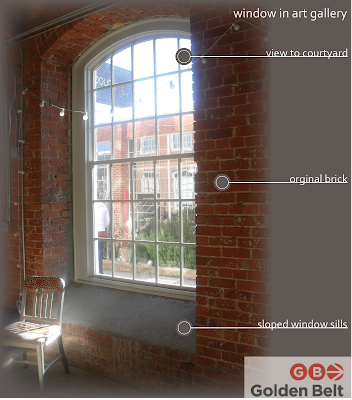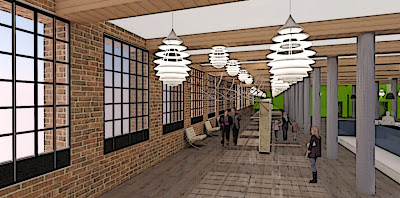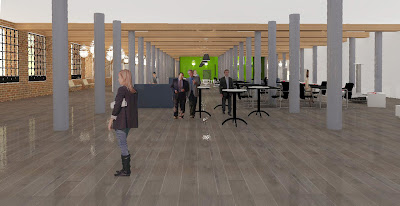Thursday, June 13, 2013
Monday, June 10, 2013
A full description
Starling Darling
I
felt it necessary to explore and emulate nature’s beauty. The Starling have many features that inspires
the construction and the sustainable features of the chair. Starlings are medium-sized song birds with
triangular wings hence the inverted triangular shaped arms of the chair. They have strong feet and their flight is
strong and direct. By mimicking this
concept in the chair, it’s smaller than most accent chairs in size
[3’10”
H x 2’ 7” W x 1‘8” D] and unusual shaped arms and legs are stronger than most
built chairs. I consulted the bird’s
skeletal system and applied the underlying design principles to shape, form,
and construct a sustainable piece of furniture that can carry it’s weight for
many years to come.
Furniture
has always found inspiration on the fashion runways, from color trends to
fabrics to construction. The link between fashion design and furniture design
is strong and everlasting.
Starling
Darling is built for comfort; therefore, it is also equipped with mechanics
that features some of today's most technological advances in bio-textiles and
electronics. Due to this blend of these
extraordinary components, a great deal of thought has been placed in the
analysis of kinetics, center of mass, and human comfort zones. The back of the chair is motorized and
reclines in the 3 most common positions for an adult.
The
“Starling Darling” is designed to highlight that close relationship to fashion
and to showcase its connection to nature.
It’s a perfect fusion
of
high fashion, kinetics, and biomimicry!
Friday, February 1, 2013
Bringing New Life & Character to Pickett Cotton Mill
Students:
This studio will unfold the reimagining of the historic Pickett Cotton Mill in southwest High Point through a rehabilitation that understands the mill’s authenticity, respects it past ‘voice” and expresses its future ‘voice’ within a revitalized Southwest High Point. Your designs will be mixed-use projects incorporating a combination of “third places” as well as apartments, live/work units, artist studios, and a childcare center. A central focus to the studio project will be developing strategies and tactics for the adaptive reuse of a historic building based on a clear analysis of its existing “voice” and its larger context. Our approach will be respectful of the building’s historic character and will be guided in part by Graeme Brooker and Sally Stone’s book Rereadings Interior Architecture and the Design Principles of Remodeling Existing Buildings and by the theory of third places from Ray Oldenburg’s The Great Good Place: Cafés, Coffee Shops, Bookstores, Bars, Hair Salons and Other Hangouts at the Heart of a Community.
This studio will unfold the reimagining of the historic Pickett Cotton Mill in southwest High Point through a rehabilitation that understands the mill’s authenticity, respects it past ‘voice” and expresses its future ‘voice’ within a revitalized Southwest High Point. Your designs will be mixed-use projects incorporating a combination of “third places” as well as apartments, live/work units, artist studios, and a childcare center. A central focus to the studio project will be developing strategies and tactics for the adaptive reuse of a historic building based on a clear analysis of its existing “voice” and its larger context. Our approach will be respectful of the building’s historic character and will be guided in part by Graeme Brooker and Sally Stone’s book Rereadings Interior Architecture and the Design Principles of Remodeling Existing Buildings and by the theory of third places from Ray Oldenburg’s The Great Good Place: Cafés, Coffee Shops, Bookstores, Bars, Hair Salons and Other Hangouts at the Heart of a Community.
Professor Jo Leminstol
Thursday, January 17, 2013
Susan Szenasy’s METROPOLIS
Susan Szenasy’s
METROPOLIS
Susan
is Editor in Chief for the world-renowned architecture and design magazine Metropolis. She graciously constructed a
presentation while on tour for the
“Inclusive Design for the Next Generation competition!” As she took the podium she is a modest, humble
and honest soul…she began to speak from her heart. With a spirit of service she shares with us
that she’s just brunt out on design contents that simply encourages creating,
building pretty worthless things, spaces.
She feels that design is more than styling and more about human
concerns. So, how does good design
derive? Susan’s short answer and theory
is, “through an interest in social and
ethological conditions”.
She
plays a short film and introduces her audience to several teams of people whom
had an interest in this very thing, or simply asked a question. We learn that Genware, the Hydro Wall, Lunar
Residence Streetlights, and the Solar Façade are all fascinating inventions by
people who perhaps recognized a problem, asked themselves a question and used
technology to solve the problem. Careful
not to believe that technology solved the problem, only helped. We understand and it’s demonstrated that
there are “NO limits to human imagination” .
I am
also intrigued that Susan unveils common mistakes / obstacles that often
prohibit many of us from moving forward with our creations. She identifies “Funds” or the lack of, would
be the number one obstacle that many of us face when we set out to design. Therefore, she explained that one could have
to fund one’s very own project. Also,
bringing in investors would be a strongly urged to jumpstart a project.
Question
: “How
do you step into the dialogue of sustainability?” Susan encourages her audience to
“think of a built environment in an organic perspective”. She believes that incorporating multiple
disciplines when designing a building is really the best approach from the
start.
Question : Do
we allow outdated technology and methods dictate our level of thinking and
doing? Or, do we rise to the occasion and
utilize recent discoveries in technology to advance in sustainability? How do you make a building breathe on it’s
own, produce it’s own heat?
Design
has to be at the center of solving problems?
Where
will I fit in the dialogue?
Visit to Golden Belt, Durham NC
We took a trip over to Golden Belt to experience 1st hand a building with similar rehabilitation qualities.
cover for booklet
We're compiling a booklet full of analysis [documents, images, precedent study, research] of the third places we may integrate in our design for PCM.
Over, Under, Around and Through
We've entered the initial diagramming and is headed to the schematic phase. We begin with the first floor spaces paying particular attention to the public circulation into and through the building, working out interior space configurations in concert with the parameters established by the original window openings and the column grid. Also address vertical circulation from the first floor down to the ground floor, up to the second floor, and out to the site including at least one accessible entrance.
To communicate the schematic designs for the first floor, we will prepare and present the following:
- An overall plan for the first floor indicating additions of interior wall systems and doorways as well as window openings. This plan should be at 3/32” = 1’-0 “ scale. It is important to show how your schematic design works in the context of the existing columns and windows. It is also important to be sure your design meets egress requirements. Assume for egress that the building is sprinklered and that the use is mixed use.
- A vertical section cut across the first floor illustrating new walls, openings, and ceilings. This should be at 1/8” = 1”-0” scale and should be cut perpendicular to Redding Drive. (Across the 100’ width.)
- Three perspective views illustrating two key spaces on the first floor and a typical public circulation pathway. Make the perspectives each large enough to fill an 11x17 sheet. Suggest light, color, and materials. Use the perspectives to illustrate your tactics for these spaces and the vocabulary of materials and features as they relate to the historic materials and features.
Feedback from the Professor
Desk Crit:
Over, Under, Around and Through
Jo's Feedback: Trusses are not speaking the same language as the building. They fight with the beams. Adding such an ornate element doesn't respect what's already there.
MY reply: this is well received because my main objective is to celebrate the authentic nature of the building.
Jo:
Ready Set Go....Just when I thought this was the final design.
Over, Under, Around and Through
Jo's Feedback: Trusses are not speaking the same language as the building. They fight with the beams. Adding such an ornate element doesn't respect what's already there.
MY reply: this is well received because my main objective is to celebrate the authentic nature of the building.
Jo:
- add stairs to exit corridors
- avoid interrupting the main entrance with walls
- sprinklers must wrap bar/grill area
- staircase in southeast entrance/exit
- path of egress exits can not be accessed through functional spaces
- rethink north corridor exit
- reposition deck/stage on north end
- show topography
Ready Set Go....Just when I thought this was the final design.
Pickett Cotton Mill + The People + The Machinery
My initial thoughts of Pickett
Cotton Mill was that it was a place that meant so much to a lot of people and
that the building itself held countless memories. Upon entering PCM one word
dominated my mind "rhythmatic". The columns, the pilasters, the windows
and even the machinery that once defined the space. I since learned that the
people who worked here were accustomed to very systematic and routine
lifestyles. Inside the doors of PCM as well as within the community, there was
a sense of order and structure; which provided a wonderful life for so many.
Success of the mill and the cotton manufacturing process was definitely one
that required skillful flow each day. One of the most critical and important
stages of this process was spinning. It is part of the textile manufacturing
process where three types of fibre are converted into yarn, then fabrics, which
undergo finishing processes such as bleaching to become textiles.
The People and the machines were
just as interwoven as the fibres were to one another. Once that idea resonated
I became fascinated with how well the two blended. You just can’t have one
without the other. I continued to research
the spinners in particularly and discovered that there are generally one or two
types:
·
The mule was an intermittent process, as the frame advanced and returned
a distance of 5ft.It was the descendant of a 1779 Crompton device. It produces
a softer, less twisted thread that was favored for fines and for weft.
· The ring was a descendant of the Arkwright
water frame of 1769. It was a continuous process; the yarn was coarser, had a
greater twist and was stronger so was suited to be warp. Ring spinning is slow
due to the distance the thread must pass around the ring, and similar methods
have improved on this; such as flyer and bobbin and cap spinning.
I am certain that PCM used ring
spinners. I am also certain that to capture the heart of the mill in my design,
I must pay homage to the two most essentials of PCM’s time…The People + The
Machinery. I want to do so with the same
rhythmatic, systematic, symmetry, and verticality as they once did. And as
always, there a softer side of things, image 4 depicts another essential
element of the mill, cotton! It is also
one that I will be careful to infuse in my ideations of an industrial design to
the revitalization of PCM. I will be certain that there is a sense of
authenticity!
mule spinning [the people]
textile equipment [the machines]
ring spinning [the people]
cotton [the softer side]
photo credit image 1 photo credit image 2
photo credit image 3
photo crdit image 4
http://en.wikipedia.org/wiki/Spinning_(textiles)
Mid-Term Presentation
The following work displays updated floor plan and sections based on the feedback from my professor as well as an in depth research analysis on my initiative.
Overall presentation board!
Rendered in Sketch-Up
Artistic filter applied in PhotoShop supports the industrial feel.
Rendered in Sketch-Up
Artistic filter applied in PhotoShop supports the industrial feel.
Rendered in Sketch-Up
Artistic filter applied in PhotoShop supports the industrial feel.
Subscribe to:
Posts (Atom)

































